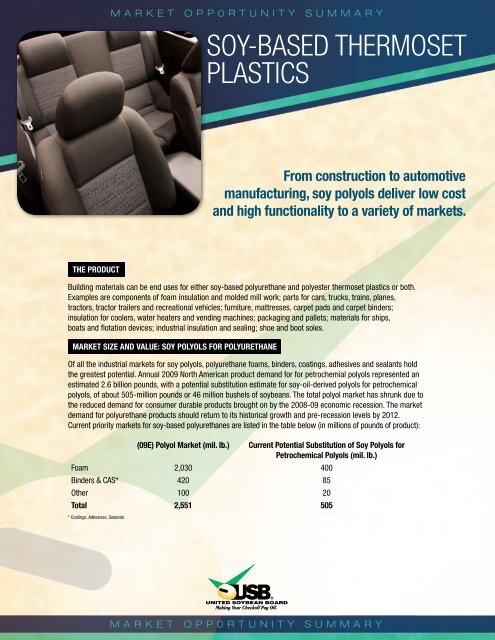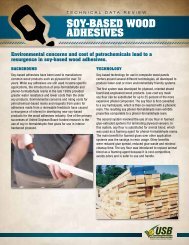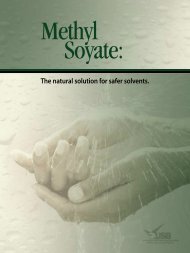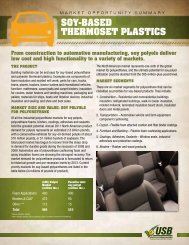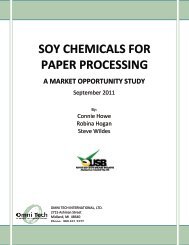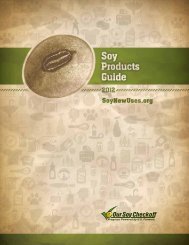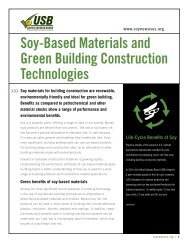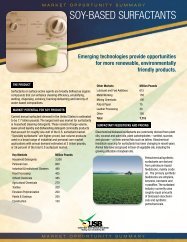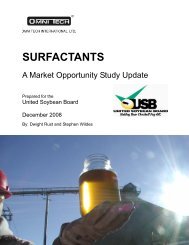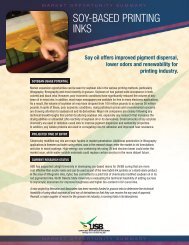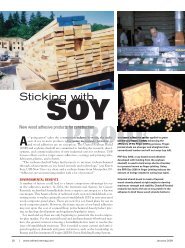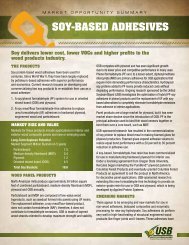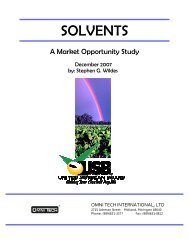SOY-BASED THERMOSET PLASTICS - Soy New Uses
SOY-BASED THERMOSET PLASTICS - Soy New Uses
SOY-BASED THERMOSET PLASTICS - Soy New Uses
You also want an ePaper? Increase the reach of your titles
YUMPU automatically turns print PDFs into web optimized ePapers that Google loves.
MARKET OPP0RTUNITY SUMMARY<br />
<strong>Soy</strong>-Based Thermoset<br />
Plastics<br />
From construction to automotive<br />
manufacturing, soy polyols deliver low cost<br />
and high functionality to a variety of markets.<br />
The Product<br />
Building materials can be end uses for either soy-based polyurethane and polyester thermoset plastics or both.<br />
Examples are components of foam insulation and molded mill work; parts for cars, trucks, trains, planes,<br />
tractors, tractor trailers and recreational vehicles; furniture, mattresses, carpet pads and carpet binders;<br />
insulation for coolers, water heaters and vending machines; packaging and pallets; materials for ships,<br />
boats and flotation devices; industrial insulation and sealing; shoe and boot soles.<br />
Market Size and Value: <strong>Soy</strong> Polyols for Polyurethane<br />
Of all the industrial markets for soy polyols, polyurethane foams, binders, coatings, adhesives and sealants hold<br />
the greatest potential. Annual 2009 North American product demand for for petrochemial polyols represented an<br />
estimated 2.6 billion pounds, with a potential substitution estimate for soy-oil-derived polyols for petrochemical<br />
polyols, of about 505-million pounds or 46 million bushels of soybeans. The total polyol market has shrunk due to<br />
the reduced demand for consumer durable products brought on by the 2008-09 economic recession. The market<br />
demand for polyurethane products should return to its historical growth and pre-recession levels by 2012.<br />
Current priority markets for soy-based polyurethanes are listed in the table below (in millions of pounds of product):<br />
(09E) Polyol Market (mil. lb.) Current Potential Substitution of <strong>Soy</strong> Polyols for<br />
Petrochemical Polyols (mil. lb.)<br />
Foam 2,030 400<br />
Binders & CAS* 420 85<br />
Other 100 20<br />
Total 2,551 505<br />
* Coatings, Adhesives, Sealants<br />
MARKET OPP0RTUNITY SUMMARY<br />
38508_MOS_Plastics 1<br />
7/9/10 2:07:18 PM
MARKET OPP0RTUNITY SUMMARY<br />
<strong>Soy</strong>-Based Thermoset Plastics<br />
The North American market represents only a third of the global<br />
market for polyurethanes, and the ultimate potential for soy polyol<br />
utilization could be tripled from the 505-million-plus-pound level.<br />
Market Segments<br />
There are six market segments for polyurethane that can be<br />
classified as priorities for soy-based products. They include:<br />
1. Construction – Residential and nonresidential buildings<br />
insulation, refrigerated buildings, walk-in cooler insulation,<br />
molded millwork, laminated insulation board stock, insulated<br />
doors and metal panels.<br />
2. Transportation – Automotive vehicle and farm equipment<br />
component cushioning.<br />
3. Carpet – Flexible foam attached cushion and fiber binder coatings.<br />
4. Furniture and Bedding – Flexible foam cushioning applications.<br />
5. Coatings, Adhesives, Sealants – Window seals, industrial<br />
adhesives and protective coatings.<br />
6. Binders – Rubber and wood products.<br />
Penetration of the six priority polyol end-use market segments by<br />
2014 is estimated to be (in millions of pounds of polyol products):<br />
Segment<br />
Market size<br />
(’09 E) (mil. lb.)<br />
Construction 700 150<br />
Transportation 500 110<br />
Carpet 280 80<br />
Furniture/Bedding 470 100<br />
Other* 600 180<br />
Total 2,550 620<br />
* Other: footwear, appliance, marine, packaging, foundry, machinery, industrial, misc.<br />
<strong>Soy</strong> polyol Potential<br />
(’14 E) (mil. lb.)<br />
The Construction Market: Rigid Foam<br />
The construction market segment can be divided into several<br />
different sub markets, as named above. Rigid foam normally has<br />
two functions: insulation (mainly in the appliance, residential and<br />
industrial applications) and structural integrity. The foam is made<br />
from low-cost, highly functional polyols and isocyanates with many<br />
additives to adjust the formulation for specific end-use properties.<br />
<strong>Soy</strong>-oil polyols have found their greatest utility in the spray foam<br />
insulation market and could compete as a reactive component<br />
in quantities of up to 30 percent of the polyol portion of the formulation.<br />
The Automotive Market: Flexible Foam<br />
Much like the construction industry, the automotive market utilizes<br />
both rigid and flexible foams. <strong>Soy</strong>-based, flexible molded polyurethane<br />
foams for seating, headrests, and arm rests are being used in<br />
almost all Ford vehicles, and also in select Toyota, Hyundai and<br />
Chrysler vehicles.<br />
Relative Economics<br />
Today, soy polyols are priced competitively with petroleum-based<br />
polyols. The polyurethane formulations, which use soy polyols, are<br />
competitive with petro-polyol based polyurethane formulations.<br />
Replacement Potential<br />
Because manufacturers<br />
typically try to optimize<br />
the cost performance of<br />
their product and meet<br />
raw material sustainability<br />
needs, soy polyols<br />
derived from soybean oil<br />
offer polyurethane manufacturers<br />
the opportunity<br />
to meet both needs.<br />
Urethane <strong>Soy</strong> Systems<br />
Company, of Volga, S.D.;<br />
BioBased Technologies,<br />
MARKET OPP0RTUNITY SUMMARY<br />
38508_MOS_Plastics 2<br />
7/9/10 2:07:29 PM
MARKET OPP0RTUNITY SUMMARY<br />
<strong>Soy</strong>-Based Thermoset Plastics<br />
Inc., of Fayetteville, Ark.; Cargill of Wayzata, Minn.; Dow Chemical of<br />
Midland, Mich.; MCPU Polymer Engineering of Corona, Calif.; and<br />
Arkema of Bloomington, Minn., have each developed a series of<br />
soy-based polyols in the process of being commercially utilized in<br />
polyurethane formulations in transportation, furnishing and construction<br />
industries.<br />
Market Size and Value: Plastic Composites<br />
The use of fiber-reinforced thermoset composites in 2009 is<br />
estimated to be less than 3.1 billion pounds. Unsaturated polyester<br />
resin (41 percent), epoxy resin (6 percent), and polyurethane<br />
(3 percent) account for the majority of the resins. Reinforcements<br />
(40 percent) and fillers (10 percent) account for the rest. About 30<br />
percent of unsaturated polyester resins are used in color-sensitive<br />
applications with no reinforcement, such as highly mineral-filled<br />
products for marble or granite-appearing countertops or sinks.<br />
The total amount of unsaturated polyester resin used has decreased<br />
from 1.9 billion pounds in 2006 to an estimated 1.0 billion pounds<br />
in 2009. This drop is due to economic recession in the major markets.<br />
Major markets for thermoset composites are transportation,<br />
construction and pleasure marine, representing 70 percent of the<br />
total consumption.<br />
Initial Market Entry And Future Outlook<br />
A collaborative effort has led to a commercial introduction of<br />
soy-derived composite products. Collaborators are Ashland<br />
Performance Materials (resin), Continental Structural Plastics<br />
(sheet molding compound), Ashley Industrial Molding (molded<br />
parts), Deere & Company (buyer) and the United <strong>Soy</strong>bean Board<br />
(USB). The result is a series of molded parts for the Model 9750<br />
John Deere Harvester combine, introduced in August 2003.<br />
Deere & Company have further specified soy-derived composite<br />
products made from sheet molding compound (SMC) in most of<br />
their SMC parts including tractor hoods. Some soy-based<br />
composites are also found on Case <strong>New</strong> Holland equipment.<br />
The basic process consists of a soy-based polyester resin that<br />
is converted into SMC using industry-accepted techniques and<br />
meeting Deere & Company specifications. More than 285 pounds of<br />
soy composite are installed on each combine. The composite material<br />
contains the equivalent of 2 bushels of soybeans.<br />
Ashland and its collaborators are working to expand the product<br />
offerings into other markets, including construction and transportation.<br />
Higher productivity through alternate processes, such as<br />
vacuum bag, resin transfer molding and pultrusion, is being<br />
examined through potential industrial partners.<br />
Meanwhile, basic product<br />
research continues on<br />
soy-oil-based resins to<br />
improve adaptability to<br />
key manufacturing processes<br />
that are efficient<br />
and economical. Interfacing<br />
with other composite<br />
raw material suppliers is<br />
important so that optimal<br />
cure conditions and mechanical<br />
properties in the<br />
final resins are obtained.<br />
Increasing interest in LEED (Leadership in Energy and Environmental<br />
Design) in the construction industry provides the opportunity for<br />
soy-derived resins from renewable resources to be used in<br />
construction applications. The interest in using renewable resources<br />
also enhances the potential for soy-based unsaturated polyester<br />
resins in other market areas such as transportation. Polyurethane<br />
composites fabricated by the pultrusion process are also being<br />
evaluated in the construction industry.<br />
MARKET OPP0RTUNITY SUMMARY<br />
38508_MOS_Plastics 3<br />
7/9/10 2:07:40 PM
MARKET OPP0RTUNITY SUMMARY<br />
<strong>Soy</strong>-Based Thermoset Plastics<br />
Replacement Potential<br />
<strong>Soy</strong> oil is an indirect replacement for the glycols (ethylene glycol,<br />
propylene glycol, etc.) and soy-based sugars can be fermented to<br />
replace the acids (fumaric, maleic, terephthalic) used to produce<br />
unsaturated polyester resins. Assuming the total replacement<br />
of the portion of the thermoset resin that could be replaced with<br />
soy-based ingredients, the total amount would be around<br />
20 million bushels.<br />
<strong>Soy</strong> oil containing unsaturated polyester resins are being produced<br />
by two major chemical companies, Ashland, Inc., and Reichhold,<br />
Inc. Other chemical companies have reported developing these soy<br />
containing resins, but no commercial activity by others has been<br />
announced. Improved reactivity of the resin system containing soy<br />
oil is a sought-after property.<br />
<strong>Soy</strong>-based thermoset composites continue to slowly gain market<br />
penetration. Interest in renewable resources drive the interest,<br />
but cost parity is a must. Pricing of soy oil compared to petroleumbased<br />
products is favorable. Aggressive marketing of the benefits of<br />
these resins helps to drive the market penetration.<br />
Another route to producing thermoset unsaturated polyester and<br />
epoxy resins from soy oil is from glycerin, which is a byproduct<br />
of the biodiesel manufacturing process. The amount of biodiesel<br />
produced in the United States will dictate the supply of glycerin, and<br />
new found uses will determine its value. The conversion of glycerin<br />
for materials to be used in thermoset composites will be driven<br />
by the economics of glycerin feedstock and the technology to find<br />
economical conversion processes. Solvay and Dow Chemical have<br />
both announced making epichlorohydrin for thermoset epoxy from<br />
glycerin. Other companies are reported to be converting glycerin<br />
into propylene glycol, which is used to make unsaturated polyester<br />
resins. Most of these announcements are for overseas plants. Other<br />
routes of producing feedstock for thermoset resins from soy meal<br />
by fermentation are being investigated. <strong>Soy</strong> meal, flour and hulls<br />
are also being investigated as fillers for thermoset plastics.<br />
ABOUT USB<br />
USB is made up of 68 U.S. farmer-directors who oversee the<br />
investments of the soybean checkoff, a U.S. soybean research<br />
and promotion program, on behalf of all U.S. soybean farmers.<br />
Checkoff funds are invested in the areas of animal utilization,<br />
human utilization, industrial utilization, industry relations, market<br />
access and supply. As stipulated in the <strong>Soy</strong>bean Promotion,<br />
Research and Consumer Information Act, USDA’s Agricultural<br />
Marketing Service has oversight responsibilities for USB and the<br />
soybean checkoff.<br />
For more information visit: soynewuses.org<br />
©2010 United <strong>Soy</strong>bean Board [38508-MOSP-3/10]<br />
MARKET OPP0RTUNITY SUMMARY<br />
38508_MOS_Plastics 4<br />
7/9/10 2:07:52 PM


